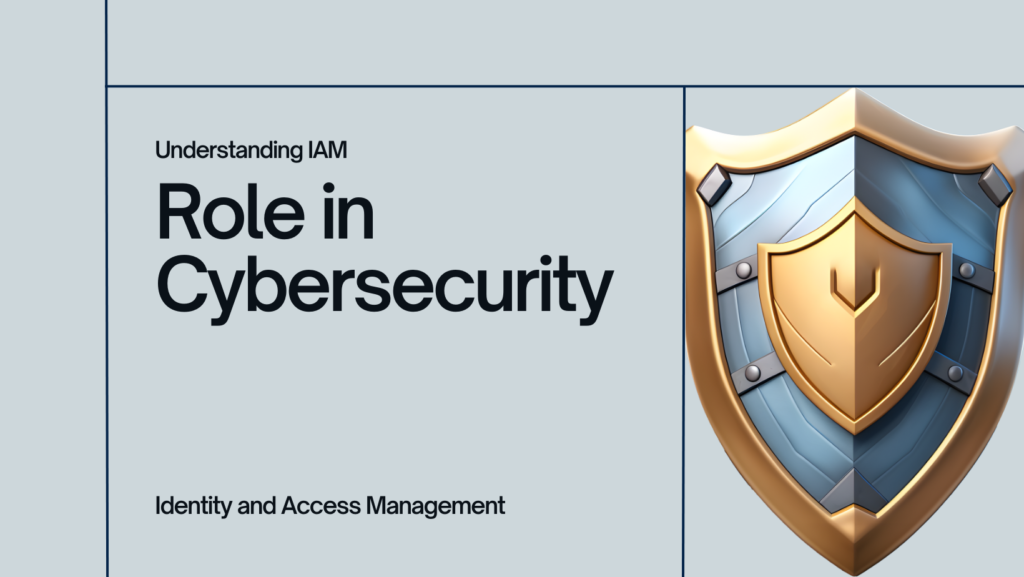What is the Role of IAM in Cybersecurity?

In today’s digital age, organizations manage vast amounts of sensitive data and critical applications across various platforms. Identity and Access Management (IAM) plays a vital role in securing these resources by ensuring that only authorized individuals can access specific systems, data, and applications. This blog explores the role of IAM in cybersecurity and its significance in modern IT infrastructure.
Understanding Identity and Access Management (IAM)
IAM is a framework that defines policies, processes, and technologies to manage digital identities and control access to enterprise resources. It encompasses authentication, authorization, and user lifecycle management, ensuring that users have appropriate access levels based on their roles and responsibilities.
Key Components of IAM
- Authentication – Verifying the identity of a user using passwords, biometrics, multi-factor authentication (MFA), etc.
- Authorization – Granting or restricting access to resources based on predefined policies.
- User Lifecycle Management – Managing user accounts from creation to deletion, ensuring proper access throughout employment.
- Single Sign-On (SSO) – Allowing users to log in once and access multiple applications without repeated authentication.
- Privileged Access Management (PAM) – Controlling and monitoring access for users with administrative privileges.
- Federated Identity Management – Enabling users to access multiple systems across different organizations using a single identity.
- Identity Governance and Administration (IGA) – Managing policies and compliance around user access and permissions.
- Access Logging and Monitoring – Keeping track of user activities to detect and respond to security incidents in real time.
Why is IAM Important in Cybersecurity?
With cyber threats evolving, IAM is essential to:
- Prevent Unauthorized Access: Ensuring that only verified users can access sensitive data.
- Reduce Insider Threats: Restricting privileges based on user roles minimizes the risk of accidental or malicious data breaches.
- Enhance Compliance and Governance: Organizations must comply with regulatory frameworks like GDPR, HIPAA, and SOC 2, which mandate strict access controls.
- Improve User Experience: IAM streamlines access management, reducing login fatigue and improving productivity.
- Mitigate Security Risks: IAM helps prevent account takeovers, credential stuffing, and phishing attacks.
- Enforce Consistent Security Policies: IAM ensures access policies are uniformly applied across all IT environments, including on-premises and cloud systems.
IAM Technologies and Best Practices
Authentication Methods
IAM solutions use various authentication techniques to verify user identities:
- Passwords – Traditional method but prone to breaches.
- Multi-Factor Authentication (MFA) – Combines multiple verification methods like OTPs and biometrics.
- Biometric Authentication – Uses fingerprints, facial recognition, or iris scans for secure access.
- Passwordless Authentication – Utilizes cryptographic keys or mobile push notifications instead of passwords.
- Behavioral Biometrics – Analyzes user behavior, such as typing speed or mouse movement, to detect anomalies.
Role-Based Access Control (RBAC)
RBAC ensures that users receive permissions based on their job roles. For example:
- An HR Manager can access employee records but not financial reports.
- A Software Developer can modify application code but not configure network settings.
Attribute-Based Access Control (ABAC)
ABAC enhances security by evaluating attributes (e.g., location, device, or job title) before granting access. For instance:
- A user accessing a system from an unknown location may require additional authentication.
- A doctor accessing patient records in a hospital may be granted access, but a remote user may be restricted.
Principle of Least Privilege (PoLP)
IAM enforces PoLP, meaning users get only the minimum necessary access for their tasks. This reduces the risk of privilege misuse.
Zero Trust Security Model
IAM aligns with Zero Trust principles, requiring verification at every access point and eliminating implicit trust within the network.
Challenges in Implementing IAM
- User Resistance to Change – Employees may resist adopting new authentication methods like MFA.
- Complexity in Managing Identities – Organizations must manage thousands of user identities across multiple applications.
- Integration with Legacy Systems – Older systems may not support modern IAM solutions.
- Balancing Security and User Experience – Strong security controls should not hinder user productivity.
- Managing Third-Party Access – Vendors and contractors require secure but limited access to corporate resources.
- Ensuring Continuous Compliance – Compliance requirements are constantly evolving, requiring IAM systems to adapt.
IAM in Cloud Security
As businesses migrate to the cloud, IAM plays a crucial role in securing cloud environments:
- Identity Federation – Allows users to access cloud resources using existing credentials.
- Cloud Access Security Brokers (CASB) – Monitors and protects data across cloud applications.
- Automated Provisioning and Deprovisioning – Ensures users get access only when needed and are promptly removed when they leave.
- Cloud-Native IAM Solutions – Many cloud providers offer built-in IAM tools for managing access in cloud environments.
Future Trends in IAM and Cybersecurity
AI and Machine Learning in IAM
AI-driven IAM solutions can detect unusual access patterns and automate identity verification processes. Examples include:
- User Behavior Analytics (UBA): Identifying suspicious login activities.
- Risk-Based Authentication: Dynamically adjusting authentication requirements based on risk factors.
Decentralized Identity (DID)
Blockchain-based IAM solutions enable users to control their digital identities without relying on centralized entities. Benefits include:
- Greater User Privacy – Users own and manage their identity without intermediaries.
- Reduced Risk of Identity Theft – Eliminates central repositories that are prone to data breaches.
Passwordless Authentication
The future of IAM will see a shift towards passwordless authentication, reducing the risks of credential-based attacks. Examples include:
- FIDO2 Authentication – Uses security keys and biometric authentication.
- QR Code-Based Authentication – Users scan a QR code with their device instead of entering a password.
Adaptive IAM
Adaptive IAM dynamically adjusts access controls based on contextual data such as user behavior, device type, and location.
Conclusion
IAM is a cornerstone of cybersecurity, ensuring secure and controlled access to resources. By implementing robust IAM practices, organizations can protect sensitive data, enhance compliance, and mitigate security threats. As cyber threats continue to evolve, businesses must adopt modern IAM solutions to strengthen their security posture and prevent unauthorized access.
Would you like to learn more about how IAM can enhance your organization’s security? Feel free to share your thoughts in the comments below!
🚀Boost Your Cybersecurity Career with Ignisys IT! 🔐
Are you ready to master the skills needed to combat cyber threats and secure digital environments? Join Ignisys IT for expert-led Cybersecurity training and gain hands-on experience with industry-leading tools and techniques.
📩 Enroll today! Take the first step toward a secure future.
For more details, contact us now!

Leave a Reply